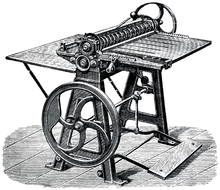Visiting card

A visiting card, also known as a calling card, is a small paper card with one's name printed on it, and often bearing an artistic design. In 18th century Europe, the footmen of aristocrats and royalty would deliver these first European visiting cards to the servants of their prospective hosts solemnly introducing the arrival of their owners.
History


Visiting cards became an indispensable tool of etiquette, with sophisticated rules governing their use. The essential convention was that one person would not expect to see another person in his own home (unless invited or introduced) without first leaving his visiting card for the person at his home. Upon leaving the card, he would not expect to be admitted at first, but might receive a card at his own home in response. This would serve as a signal that a personal visit and meeting at home would be welcome. On the other hand, if no card was forthcoming, or if a card was sent in an envelope, a personal visit was thereby discouraged.
As an adoption from French, they were called une carte d'adresse from 1615 to 1800, and then became carte de visite or visiteur with the advent of photography in the mid 19th century. Visiting cards became common amongst the aristocracy of Europe, and also in the United States. The whole procedure depended upon there being servants to open the door and receive the cards and it was, therefore, confined to the social classes which employed servants.
If a card was left with a turned corner it indicated that the card had been left in person rather than by a servant.
Next day Paul found Stubbs' card on his table, the corner turned up. Paul went to Hertford to call on Stubbs, but found him out. He left his card, the corner turned up.
Some visiting cards included refined engraved ornaments, embossed lettering, and fantastic coats of arms. However, the standard form visiting card in the 19th century in the United Kingdom was a plain card with nothing more than the bearer's name on it. Sometimes the name of a gentlemen's club might be added, but addresses were not otherwise included. Visiting cards were kept in highly decorated card cases.
The visiting card is no longer the universal feature of upper middle class and upper class life that it once was in Europe and North America. Much more common is the business card, in which contact details, including address and telephone number, are essential. This has led to the inclusion of such details even on modern domestic visiting cards, a practice endorsed by modern books of etiquette, such as Debrett's New Etiquette.[1]
Common sizes
| Width | Height | Used in |
|---|---|---|
| 85 mm | 55 mm | Germany, Italy, France, Spain, Switzerland, Netherlands, Austria, Turkey |
| 88.9 mm | 50.8 mm | United States, United Kingdom, Canada (3½ × 2 in) |
| 90 mm | 55 mm | Australia, India, Sweden, Norway, Denmark |
| 90 mm | 54 mm | Hong Kong |
| 90 mm | 50 mm | Argentina, Finland, Russia, Hungary, Poland, Romania |
| 91 mm | 55 mm | Japan |
| Width | Height | Format |
|---|---|---|
| 74 mm | 52 mm | DIN A8 |
| 81 mm | 57 mm | DIN C8 |
| 85 mm | 55 mm | check card (EU) |
| 85.6 mm 100 mm | 54 mm 65 mm | check card (ISO 7810) check card with photo |
See also
- Business card
- Carte de visite, a related but usually distinct item
- Compliments slip
References
- ↑ Morgan, John (2001). Debrett's New Guide to Etiquette & Modern Manners: The Indispensable Handbook (1st U.S. ed.). New York: Thomas Dunne Books/St. Martin's Press. ISBN 0-312-28124-2.
- Ray Trygstad. "Calling Cards", Rays of Light July 21, 2003
- United States Army. Army Regulation 600–25 Salutes, Honors, and Visits of Courtesy Washington, DC: Headquarters, Department of the Army, 24 September 2004.
- Emily Post. "Cards and Visits", Chapter 10 of Etiquette in Society, in Business, in Politics and at Home. New York: Funk & Wagnalls Company, 1922. ISBN 1-58734-039-9.
- Robert Chambers, editor. "Visiting Cards of the 18th Century", Chapter 5 June of the Book of Days. London: W. & R. Chambers, 1869.
External links
| Wikimedia Commons has media related to Visiting cards. |
- Social Calls in the Edwardian era
- The Etiquette of Using Calling Cards
- Collection of calling cards received by Mrs. John Beckwith, Chicago at the Newberry Library